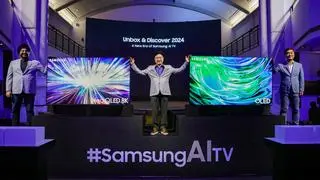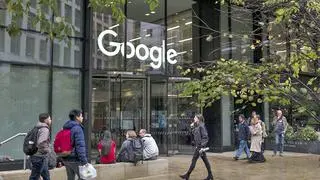With the Asia-Pacific region proving to be the fastest growing at 21 per cent for Autodesk Inc, the region's Senior Vice-President, Patrick Williams, has a constant stream of projects on hand. Based in China, and with a firm finger on the pulse of the emerging markets, he is not only spreading the word on the importance of design technology but also helping companies innovate, save costs and cut waste. In a freewheeling interaction, he speaks to eWorld on the company's software offerings.
You have just launched your 3D design and engineering software portfolio, including the Autodesk Product Design Suite. How is the market reacting to the products?
It's a matter of how intentional are we about going to the market with regard to industry. So we have about 80 products in our portfolio, and we look at which is the best product that suits each customer's requirement. However, what we're doing with the Suites is that we're taking those 80 products and going to the architecture industry. We're putting together solutions that will be more tailored for their use. .which can help them become more productive, efficient, save costs and be greener…
When you say that your products help companies become more efficient, save them costs and aid in their becoming more green, what percentage would you put on it?
It varies from customer to customer and each one has its own internal goal on being green.
All our customers are internally trying to reduce costs, let me give you an example of cost saving. We work with Marriott Hotels. Historically they have been working on their new product design (which is actually their room designs) using physical prototypes. So they would go into the hotel, build rooms, bring in consumers, get feedback and build hotels based on that. By bringing in Revit Architecture, design visualisation that will allow them to do it in a digital environment, they were able to save 91 per cent of their cost in their new construction.
When we talk about being more efficient, it can mean being more productive, greener; 40 per cent of the world's energy consumption comes from building. If there is anything that we can do to reduce the consumption for building, it's going to be an added benefit to them. There is a tremendous amount of waste that goes into building so you can save 10-20 per cent or even more of your cost by eliminating waste that is generated in a particular project.
In India, Autodesk has helped L&T to be 80 per cent more efficient on time optimisation. How was it done?
The L&T Monorail project in Mumbai is a good case study for us. It has a different kind of footprint. There weren't any proper solutions available for monorail design and they saw our solution as the best one available.
How are you using cloud computing for design?
When you talk about design visualisation, it is a very compute-intensive application. Most architecture firms can actually go onto the cloud, and put their design into the rendering environment. This saves them time and money because they don't have to make a capital investment for the actual servers.
We have about 16 applications that are available on Autodesk Labs which we hire out to our customers. A lot of things that we're working on are piloting onto the cloud and most of these will become mainstream sooner or later
Is piloting on the cloud saving costs? Why do you need the cloud?
I would say there is an investment there for us. For now it's not a cost, it's more of a consumer initiative. You need the cloud for storage capabilities. There are some sophisticated tools there, we focus on the content.
Our product AutoCAD WS is a mobile platform for customers. For example, you have an iPad, you're doing a design of a building and it's in the middle of construction. You can bring your iPad with you, download software from the Web and if you feel something needs to be changed, you can go online and make that change. That change automatically goes to the cloud and gets saved there.
The number of people you're collaborating with can access that at the same time. It becomes a collaborative tool. It facilitates high-end computing. A lot of things happen with going to the cloud, it's not just cost associated.
During the Australian Open, 20 iPads were given to the team. They were actually able to map out information back to the main tent, the headquarters. They saved three-four hours a day, and didn't need to go back and forth the entire day. These are the kind of things we're trying to promote and facilitate. That's the efficiency we talk about.
WS (Web Service) is a free application. What we provide is not just the application but also the storage on the Web. Probably, some day, you may not even need a computer, you just do everything on the cloud. These applications work on the iPhone and we're coming out with an Android version.
Do you plan to price these later on?
No, we won't. In some places we're making the abilities as part of a subscription. If they're on subscription with us, they'll have access to different technologies.
At the other spectrum we have products such as HomeStyler which is really focused at the consumer level; let's say you want to re-design your bathroom. You don't have to go out and buy software, you can go online, use our tools and build your design on the cloud and download the drawings. It is focused on the consumer, but what it really brings us is brand-name awareness, it gives people a look and feel of our products and helps promote Autodesk.
What has your experience been in India? Do you think design is given enough importance?
I think in countries such as India and China that are heavily based on manufacturing, design is becoming more and more critical. As manufacturing becomes more competitive on a local scale, we see South- East Asia coming into play, much bigger than the past. I think it's just natural for countries such as India and China, which have a well-educated workforce, to start moving from that manufacturing-centric base to a design-centric base. I think design is how people differentiate themselves. Anyone can build one of these but how it looks, how it feels, how it performs is all up to design. When someone has a better design, that's when you want to get your competition.
Where do you find it easier to do business — in China or India?
Both the cultures are very straight forward which makes it easy to do business…There is a lot of excitement from our customers and partners, and the government is taking a lot of initiatives in infrastructure. So it's an exciting time to be here in India and China. We have so many different products that touch across multiple industries — manufacturing, architecture, engineering and construction.. We have over 10 million users, which are more than all of our competitors combined.
Autodesk keeps talking about democratising technology. Could you explain the concept?
What we do is bring very sophisticated technology to the masses. So when I talked about having 10 million users worldwide, which is more than all of our competitors worldwide, it is a perfect example of how we democratise technology. What we focus on… is that people who wouldn't have access to some high-end simulation and analysis tools to be able to get access to that and to be able to do better design without huge expenses.
What is in it for you?
It is brand, the fact that AutoCAD is so well known, it has given us a vehicle to expand into the different market segments.
Ten years ago, when you talked of Autodesk, primarily we were known as 2D drafting company. Now we're known as a manufacturing, an architecture and engineering company…
So yes, we are financially focused…our stock has a great run, we are up 200 per cent in the last two years and it has been a fantastic couple of years for us…we are planning to acquire new technologies and bring those to market.








Comments
Comments have to be in English, and in full sentences. They cannot be abusive or personal. Please abide by our community guidelines for posting your comments.
We have migrated to a new commenting platform. If you are already a registered user of TheHindu Businessline and logged in, you may continue to engage with our articles. If you do not have an account please register and login to post comments. Users can access their older comments by logging into their accounts on Vuukle.